The old saying “head west” previously suggested opportunities on the frontier, maybe even for gold mining. Today, it could better describe your chances at a trophy-sized Largemouth Bass. In fact, 21 of the biggest 25 Largemouth Bass in the US were caught in California!

The Golden State offers quality Bass fishing for those in the know. Understanding why Bass grow so well here, identifying good fishing spots, and selecting the right gear will improve your chances out on the water. Native or tourist from abroad, you need to put this state on your list of places to fish out west. And here, we’ll cover everything you should know about catching big Largemouth Bass in California.
The History of Bass in California
With a reputation as a trophy Bass producer, some anglers are shocked to discover that Bass actually aren’t native to California. The Smallmouth Bass was the first to hitch a ride to California. Fish from Champlain, New York, were placed into the Napa River in 1874. Eager anglers fished them out, so it wasn’t until a second introduction in Crystal Springs Reservoir that the Smallmouth established itself here.
Then, Striped Bass came to the Golden State in 1879 and again in 1882, before a northern subspecies of Largemouth from Illinois arrived at Lake Cuyamaca in 1891. The Florida subspecies of Largemouth didn’t arrive until 1959! Finally, two subspecies of Spotted Bass, the Kentucky Bass, and the Alabama Bass, have also come to California as transplants in recent decades.
Different Types of Bass in California
The California Department of Fish and Wildlife lists three types of Black Bass, along with Striped Bass, as available to catch in the state. The three Black Bass species include Largemouth, Smallmouth, and Spotted.
Largemouth Bass includes the northern and Floridian subspecies, but it’s the Florida strain, in particular, that Bass anglers flock to California’s waters for. A diet high in trout and salmon makes 10+ lb fish more common here than in other western states. Southern waterways offer longer growing seasons, showcased by the 1991 catch at Castaic Lake weighing 21 pounds, 12 ounces.

Smallmouth Bass is another popular species, with waterways in northern California offering ideal conditions for a big specimen. A steady diet of invertebrates and feeder-sized fish keep Smallies growing. You can find plenty of Smallmouth between 2– 6 pounds that are sure to fight hard. The state record for Smallmouth Bass in California weighed 9 pounds, 13 ounces, caught in Pardee Reservoir in 2007.
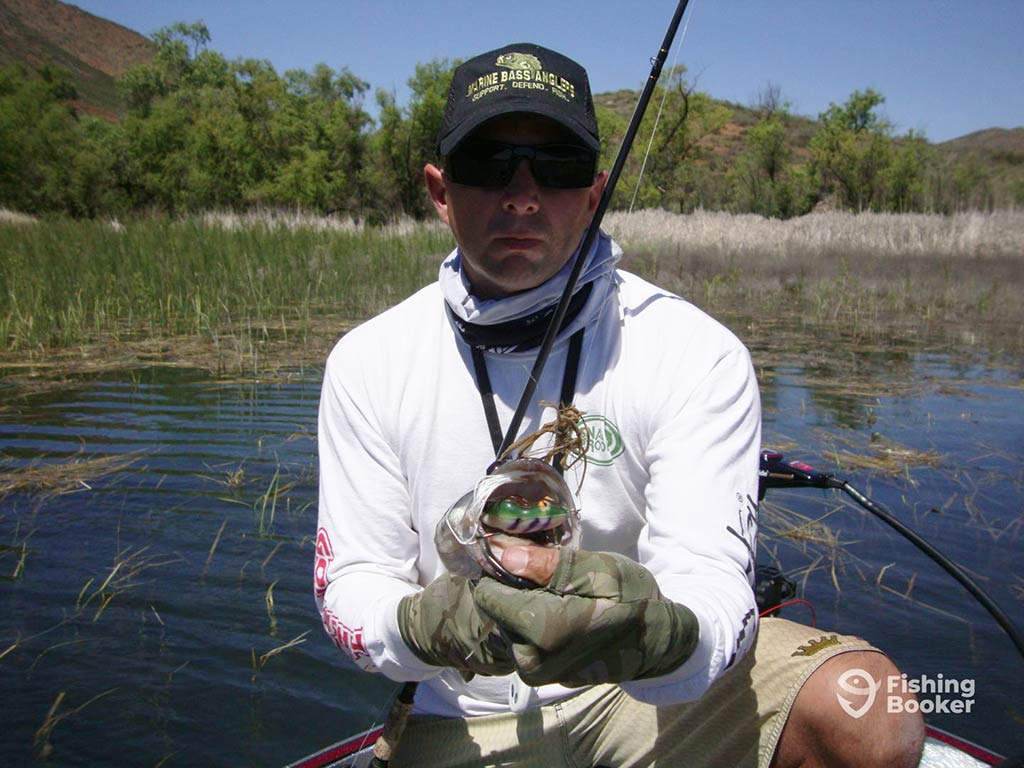
There are two Spotted Bass transplants here, the Alabama Bass and the Kentucky Bass. You can find plenty of sizeable specimens thanks to the favorable weather and their rich – similar to that of Smallmouth. The state record for Spotted Bass is also the current world record, a wall-hanger weighing 11 pounds, 4 ounces out of New Bullards Bar Reservoir in 2017.
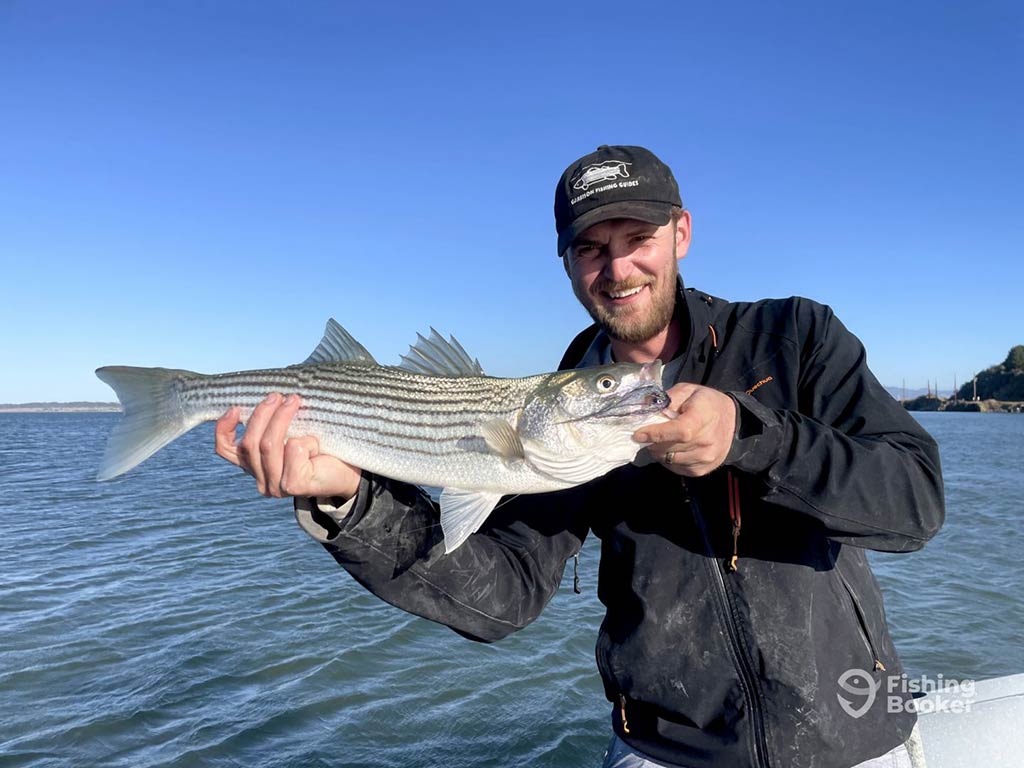
The Striped Bass is an anadromous species migrating between fresh and saltwater environments. They grow fast, with four-year-old specimens reaching 20 inches. Small fish – invertebrates like shrimp and worms – help these fish reach adulthood and help anglers catch them. The California state record was taken by O’Neill Forebay in 1992, weighing 67 pounds and 8 oz.
California Bass Fishing Lures
If you plan on hitting the spring spawn (and you should), buzz baits work nicely along the surface of shallow waters where some bruisers might be ready to spawn. Spinnerbaits work well here too. The commotion caused by these lures can produce reactionary strikes even when early spring Bass might hesitate,
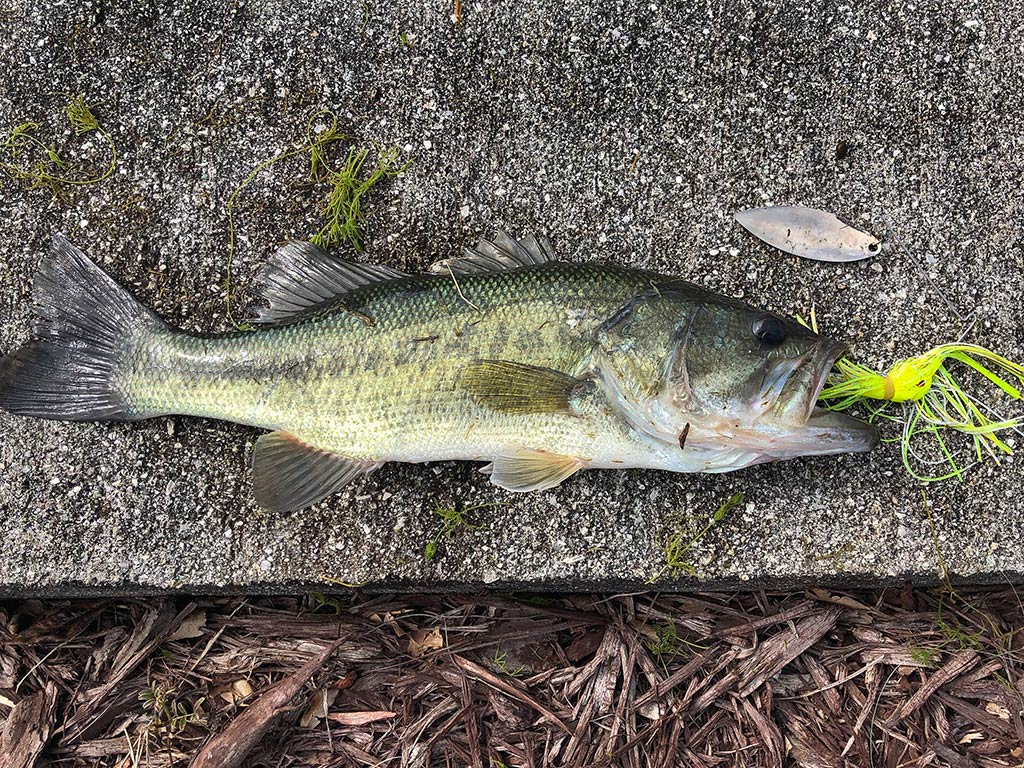
When summer hits, you can try swimbaits above grass or other structures. Cast along the sides of the blowdown to entice those lunkers to rise to your lure. A jerk bait will reach deeper into those ravens and along the edges of drop-offs.
As one of the most well-known lures for Bass, plastics work well everywhere, including the waters of California. Dust off those crayfish, frogs, and worms to work the bottom substrate. Dropping dressed-up jigs off a rocky shore can reach fish holding in deeper waters.
Focus on colors and patterns that mimic local food sources. Trout patterns might work well when your metallics are not. Don’t forget that trout is one of the foods that Bass are big on. Darker colors in the murky natural waterways can provide a silhouette that looks natural on some of your soft lures for fish looking to snack on an invertebrate.
Best Lakes for Bass Fishing in California
Both lakes and rivers are well-known to produce quality Bass across the entire state of California. Here are five of the best locations known to produce Bass in California.
Sacramento–San Joaquin River Delta

If you want to swing all four Bass species into your boat, you can’t go wrong with a trip to the California Delta. Large swaths of water average only 5 feet in depth, and tides can cause changes of several feet in either direction.
There are over 1,100 miles of waterways, with 1,000 launch ramps and 40 small marinas to help you get in the water. You’ll also the docks and shorelines near the launches as good places to cast around if you’re fishing from the banks.
Clear Lake

This natural lake only reaches 59 feet deep, which might explain why it’s warmer than most other bodies of water in northern California. Those warmer temperatures and natural nutrients help Largemouth thrive here. You have a reasonable shot at swinging a 10+ lb lunker into the boat.
You can find several launch points for boats around the lake, and shore fishing is possible with access through public parks. You’ll find plenty of structure for Bass to use for ambush, as this natural lake has plenty of vegetation. Local anglers cast along the edges of the tules, which grow along most of the shoreline here.
Castaic Lake
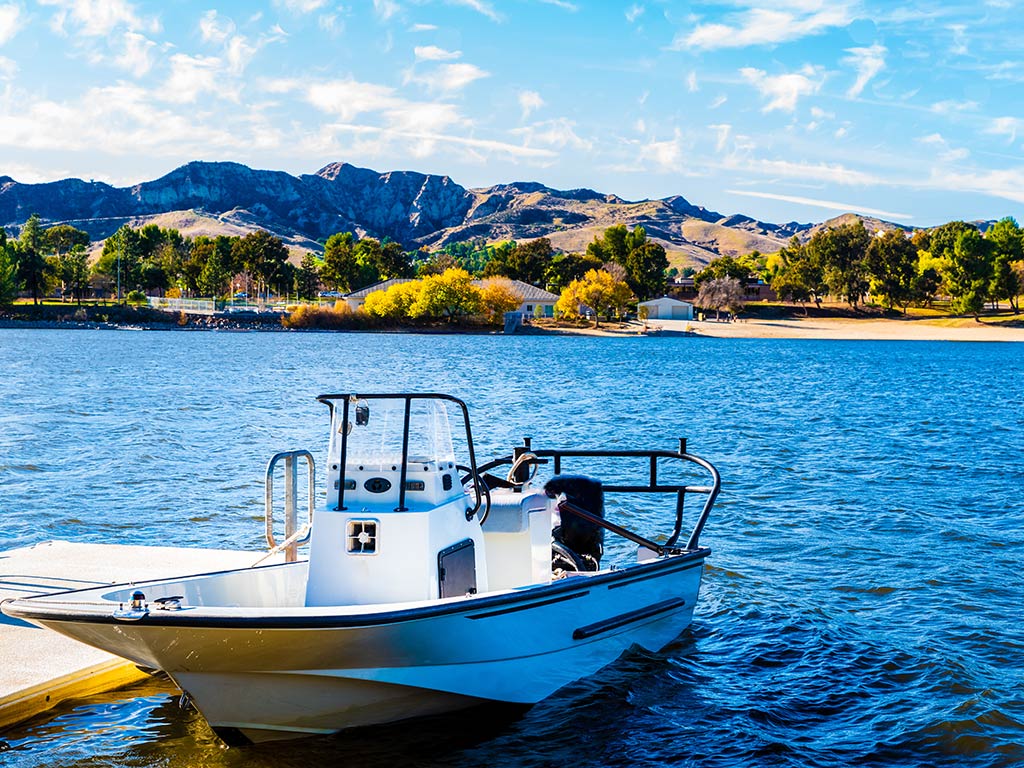
Largemouth and Striped Bass are available in this waterway in southern California that spans over 11,000 acres. The maximum depth is 330 feet, but you’ll tend to find Bass here in shallower waters – the state record was reeled in near a boat ramp. The lake has a reputation for producing 10+ lb lunkers consistently, making it a hub for tournaments.
The lake has a 24-hour fishing pier equipped with a fish cleaning station. Some of the favorite locations for local anglers include spots on the eastern arm. Try C-Point, Government Cove, and the waters near the main boat ramps.
Lake Oroville
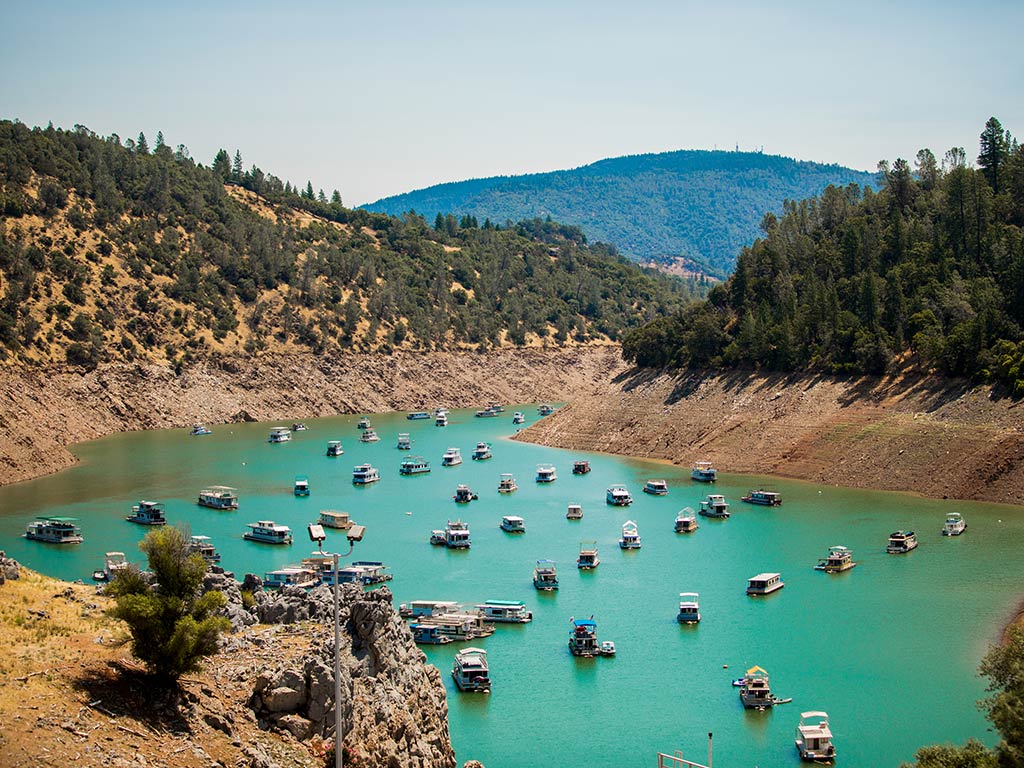
If you want to stay busy catching Bass between 2–5 pounds all day, this lake is for you. You can catch Largemouth in these waters, but Spotted Bass have taken the top spot at this northern California waterway. It’s possible to get 50 fish per day on the lake!
Being the second-largest reservoir in the state, it has an impressive depth of 690 feet at its deepest. You’ll find the Bass using the submerged trees in these waters as ambush points. There are five boat ramps at Lake Oroville (three are accessible 24 hours), which you can use to hit the water. Shore fishing is more challenging here due to the terrain where the reservoir sits.
Diamond Valley Lake

This southern California lake reaches up to 260 feet deep and covers 4,500 surface acres. It’s a clear reservoir with a rocky bottom broken up by submerged bushes. This lake is known for colossal Largemouths that enjoy feeding on the regularly-stocked trout. Bass in the 4–6 pound range are more common, but you can also land a 10-pounder from Diamond Valley Lake.
If you want to fish from the banks, there’s a 1.5-mile stretch of land west of the marina. You’ll find fishing from a boat more productive here, though.
Bass Fishing in Northern California vs. Southern California
One of the hottest issues among anglers is the about over northern and southern California’s fishing productivity. The California Department of Fish and Wildlife states that most trophy-sized Smallmouths come from northern California. That makes sense, as these lakes have cooler temperatures.
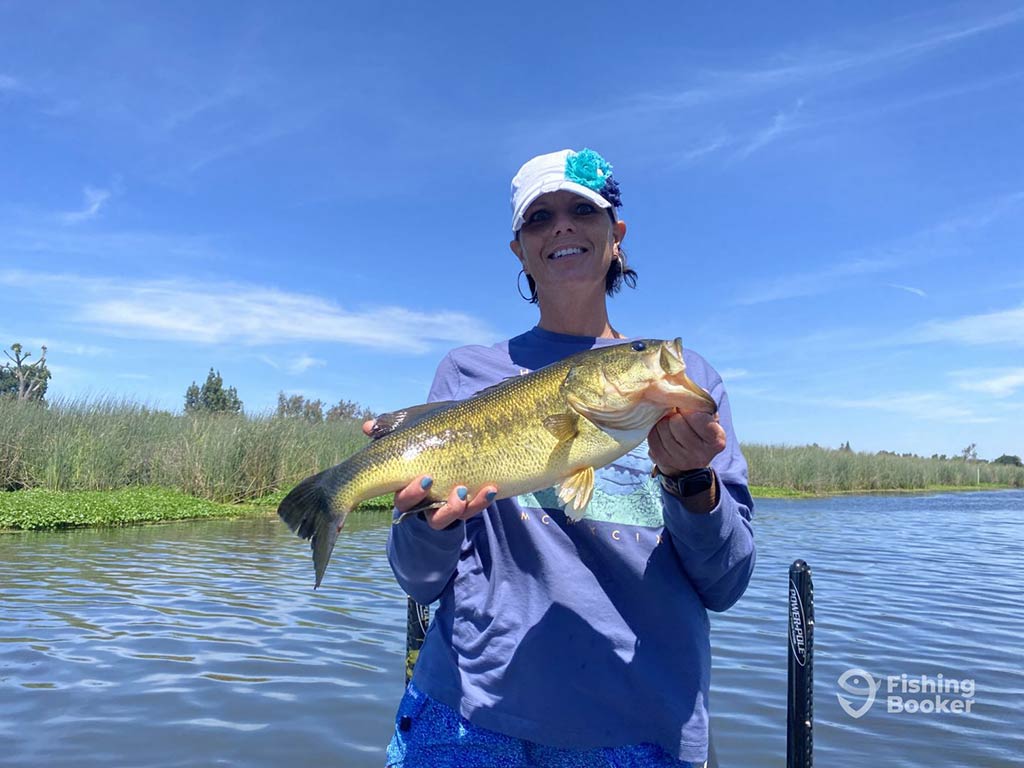
Conversely, the Florida strain of Largemouth thrives in the warmer waters of the southern part of the state. The genetics of these fish allows them to grow large, and longer growing seasons help them reach impressive sizes more quickly. It’s also worth noting that cold water does more than stunt the growth of Largemouth – it can be deadly.
Spotted Bass have taken over some northern California waterways, like Bullards Bar Reservoir. They tend to prefer warmer moving waters, however. You can find Striped Bass along the length of California, but they tend to move north as the temperature rises. The San Francisco Bay region in northern California offers good fishing opportunities for these fish.
California Bass Fishing Regulations
If you’re looking to hit the water in your boat, there are some things you need to prepare for ahead of time. The California Division of Boating and Waterways prohibits anyone under 16 from operating a boat with a motor of 15 horsepower or more (except sailboats under 30 feet). All boats powered by a 15 HP motor or larger must have someone 16 or older in control with a California Boater Card.
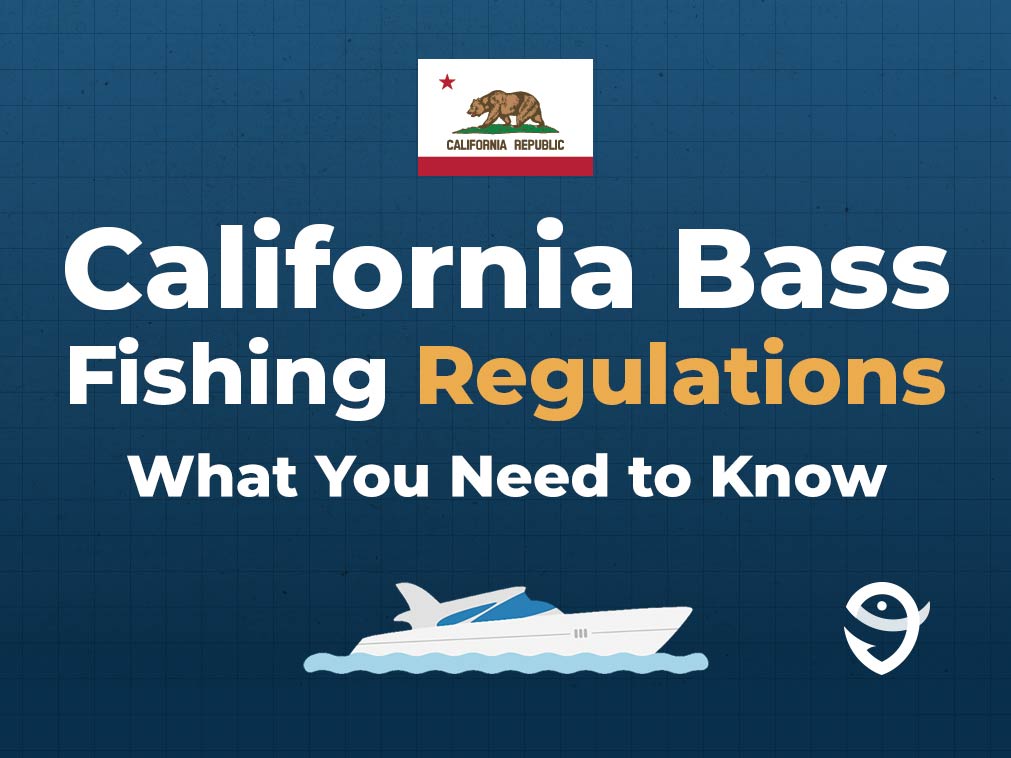
A sailboat over 8 feet or a boat with a motor of any size must be registered with the California Department of Motor Vehicles. That includes dinghies and motorized houseboats. Canoes and other boats powered by paddles are exempt from these requirements, as are sailboats under eight feet. Renewals happen every odd-numbered year (2023, 2025, etc.).
Boat trailers require a separate registration. You must also follow all safety equipment regulations. These can vary depending on the type of boat you have. Safety equipment includes lifejackets, lights for navigation, and audible/visual signaling devices.
Another thing you need to use your boat for fishing in California is a Quagga Sticker. All watercraft operating in freshwater settings must have this Mussel Fee Sticker. These fees fund efforts to combat quagga and zebra mussels.
Once the things above are covered, you should be ready to hit the water. The only other consideration now will be to pay any park or waterway fees. Also, look for any posted regulations specific to the location.
California Bass Fishing FAQs
The key to their size is the environment they live in. California Bass has favorable temperatures that generate a longer growing season. That translates to faster growth over more time each year. Combine that with a good forage base, favorable competition factors, and temperate seasons compared to some states, and you have ideal conditions for the species to flourish.
You cannot night fish on the American River between Interstate 80 Business Loop and Nimbus Dam. Heenan Lake and all waterways in Mono County (except for Topaz Lake) are also no-gos for night fishing. Finally, Tahoe Lake prohibits night fishing two hours after sunset through one hour before dawn.
Bass: The California Gold Standard
Today’s pilgrimage to the Golden State offers you a chance at some of the best Bass fishing in the western half of the US. While Bass aren’t native, species like the Florida Largemouth have thrived in the California sunshine, taking advantage of long growing seasons and access to trout and salmon as food sources.
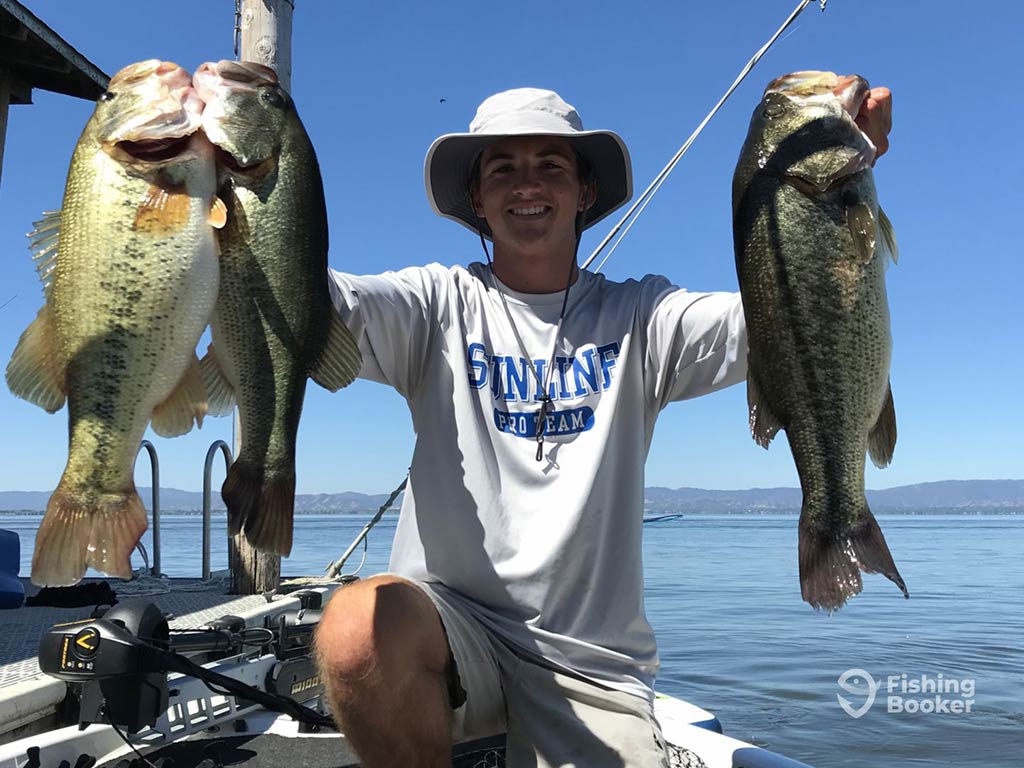
Record-breaking Largemouth isn’t the only Bass you can catch here. Smallmouth, Spotted, and Striped Bass all call this state home. While the northern part of California offers colder waters than its southern fisheries, all four Bass species are fishable nearly anywhere in the state.
You’ll find spring to be the most active time of year for Bass, and they accept the same types of lures as used elsewhere in the country. Look for colors and patterns that mimic the trout and salmon that act as food sources for these apex predators. If needed, leverage some insider knowledge with a popular California fishing charter and you’ll quickly become familiar with the “California Gold Standard!” Tight lines.
Have you ever been Bass fishing in California? How was your experience? Any tips or favorite locales to share with us? We’d love to hear from you in the comments below!
The post Bass Fishing in California: An Angler’s Guide appeared first on FishingBooker Blog.
https://ift.tt/6HPnXq7
0 Comments
Enregistrer un commentaire